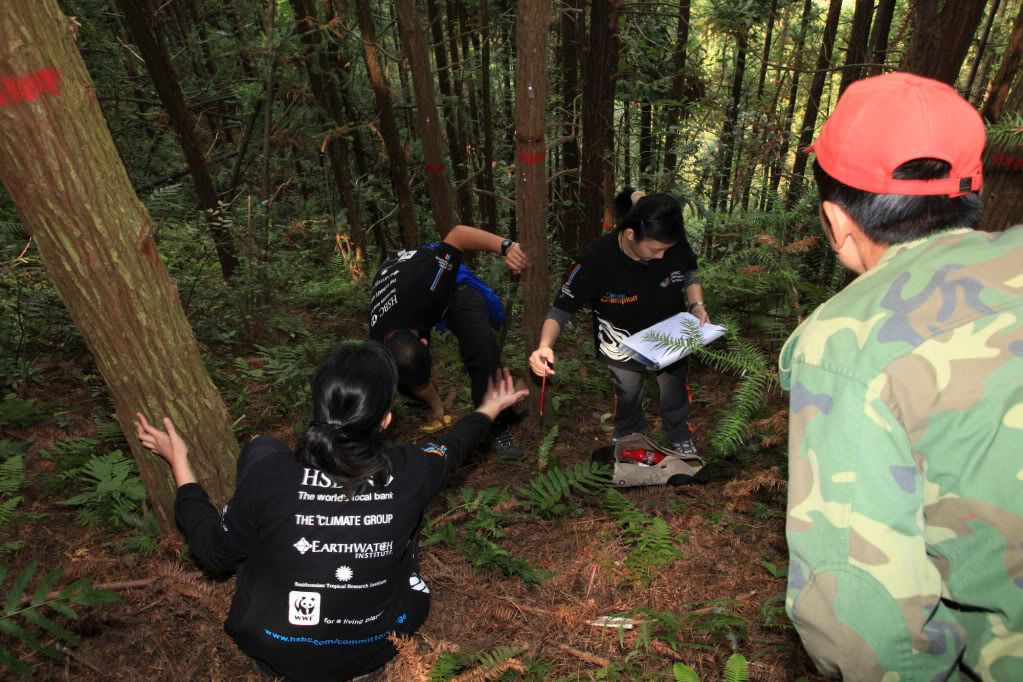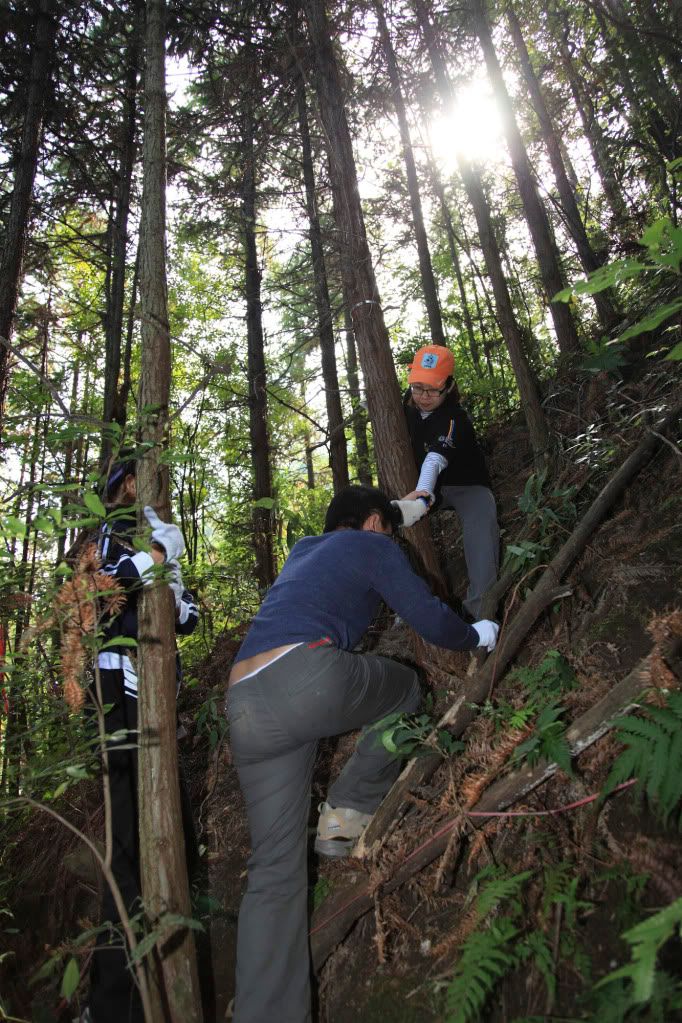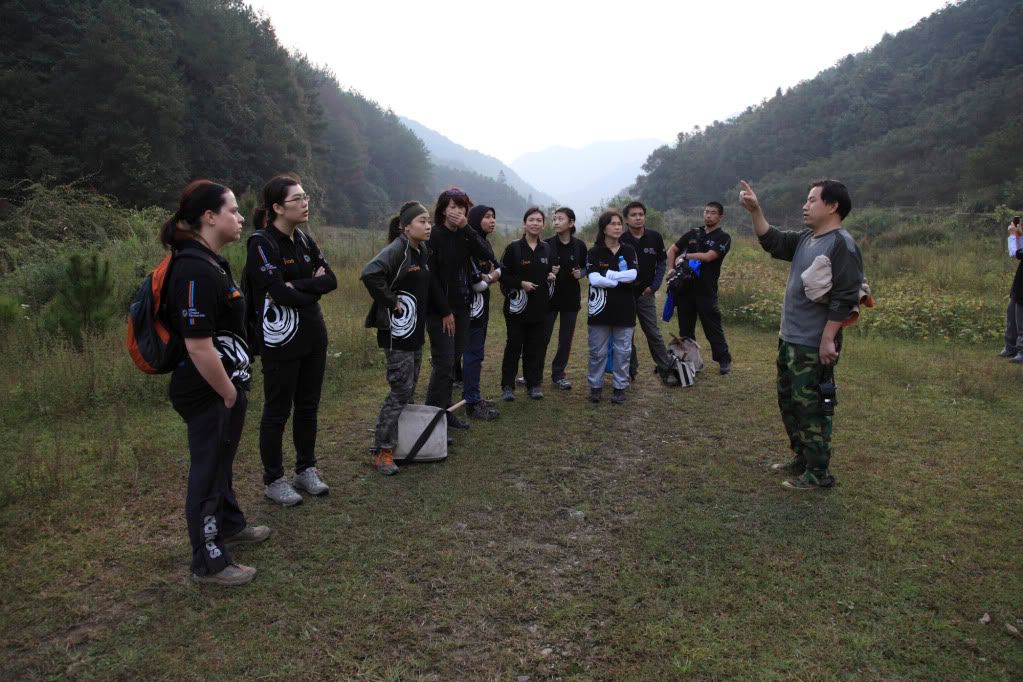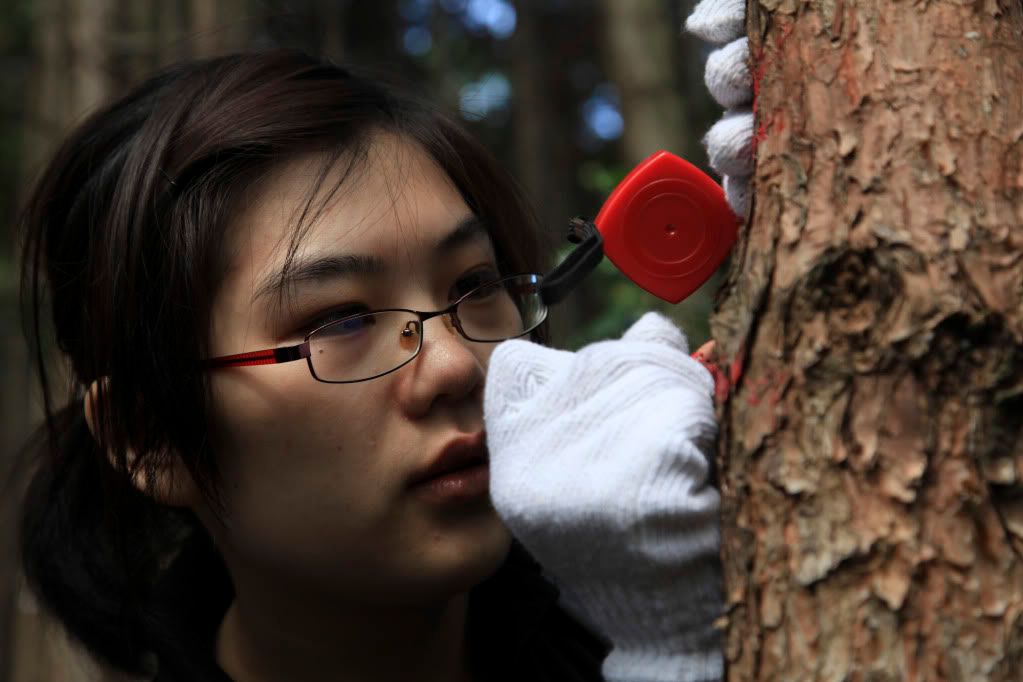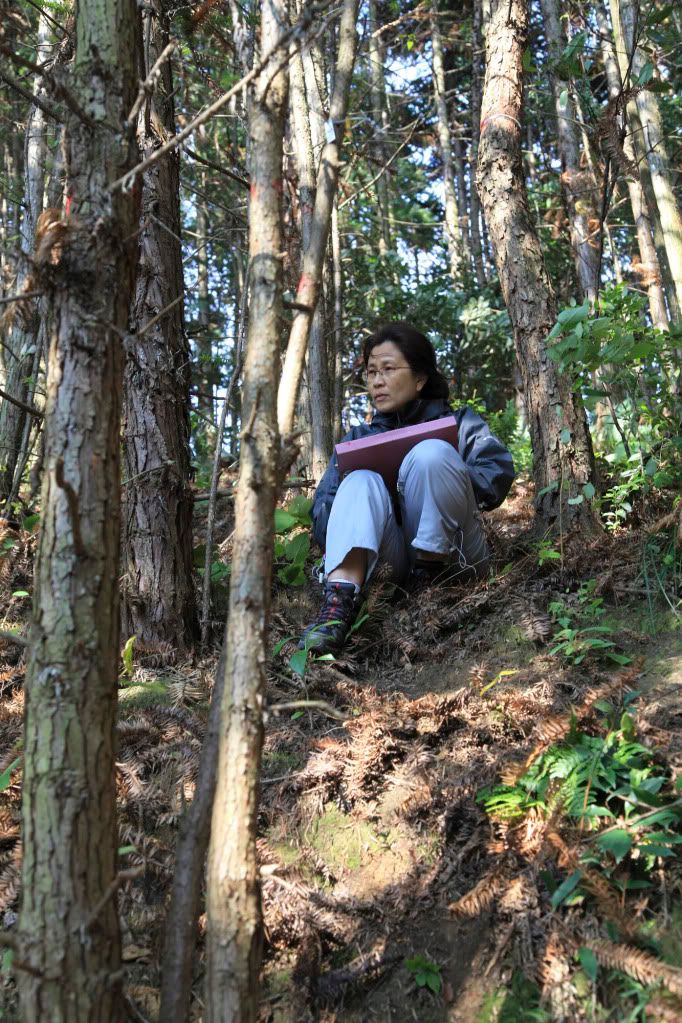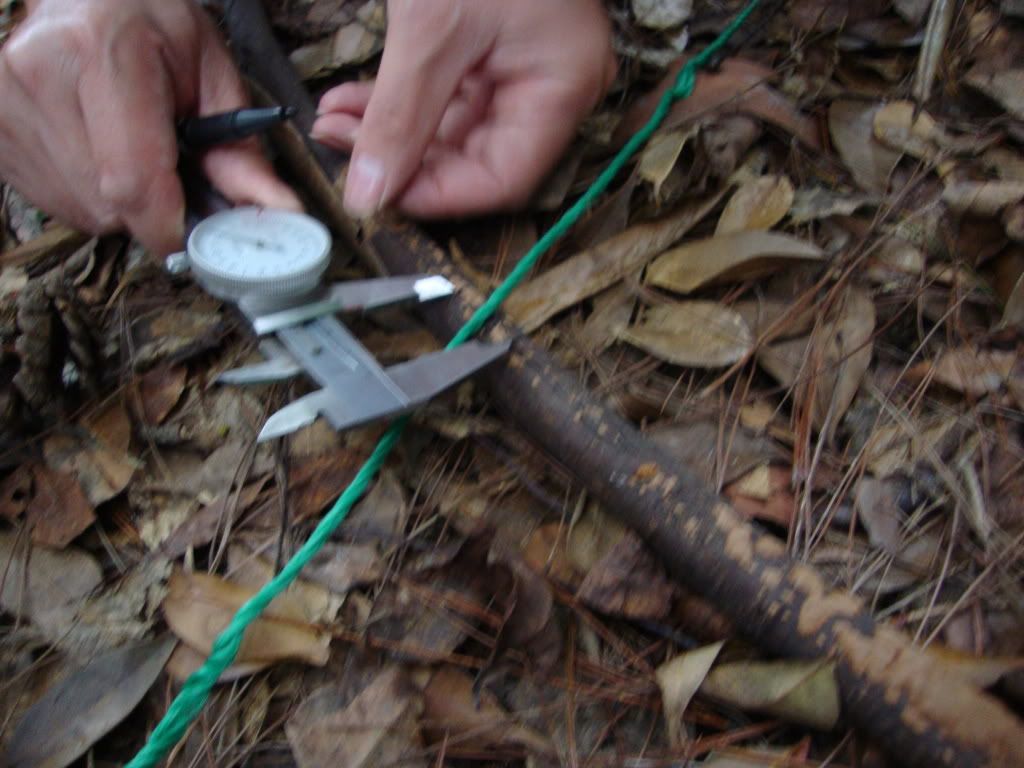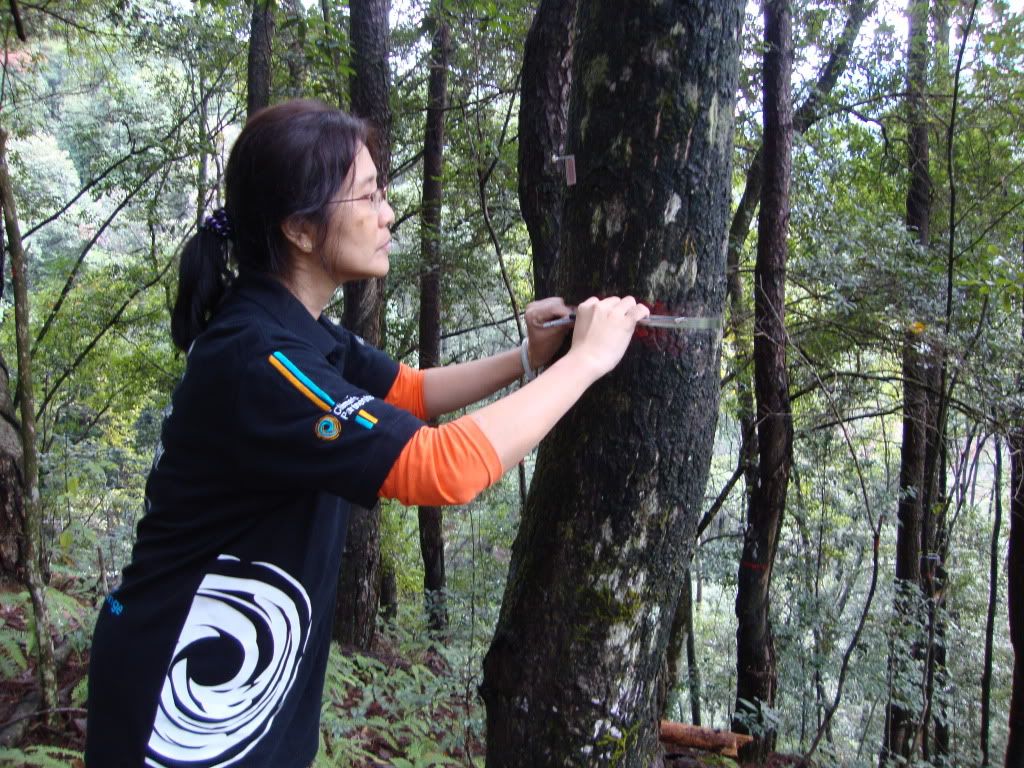

Thursday, November 25, 2010
Magpie @ China Gutianshan
During a walk out of GutianShan villa with my fellow Climate Champion , we heard continuous chain of chirping sound.
We were walking near a plot of harvested padi field. Just then a flock of Magpie birds flew by. Their beautiful tails caught our full attention. For a momemt, we forgot about our motive - Food ! We were actually walking to a nearby village to buy chocolate.
On my return to Singapore, the images of this beauty bird hover in my mind.
Thank to Jern (photo) and Luan Keng (identification).
According to Wikipedia, the Black-billed Magpie is considered as Korea National Bird. Check out this link
Check this link for a video on Blue Magpie
Interesting facts :
Belong to crow family.
Feeding on insects. Grasshoppers is it's favourite meal.
In autumn and winter, it feeds on acorns and fruits. Hmm....no wonder we also spotted them in the plantation forest.
Yellow-billed Magpie loves tall trees along river.
You may spot their dome-shaped nest (build out of sticks and mud) on high branch. Similarly, Grey Heron also built it's nest on high branch.
Tuesday, October 26, 2010
Climate Change - Gutianshan
Together with 11 climate champion from Vietnam, Philippine, Thailand, Malaysia, China, Hong Kong and Indonesia, I had spent 2 meaningful weeks learning about Climate Change from Earthwatch.
Thank to the guidance from Dr Pei, Dr Ren, Anna and Yi Fei, Team 17 had completed our attachment at Gutianshan.
The walk up the mountain wasn't an easy task.
Nevertheless, Team 17 make it with never ending words of encouragement and helping hands.
Tasks done : waking up at 5am and assemble by 6am, climbing up the mountain to measure DBH and window size, collecting and sorting leaves litter, identifying woody debris, measuring hardness and etc
- Having breakfast before field trips.
- Weather turning cool at the summit....brr.
- Measure PMO
- Recording data
- Measuring wood debris
- Measuring the windows gap
Watch "Wake Up, Freak Out", this is my wakeup call. How about you?
Saturday, April 10, 2010
Semakau - 3Apr2010
Went to St Joseph Church on 2April, catch in the rain and was down with a bad flu. Neverthless,the attractions in Semakau drew me there once again on 3April.
Due to insufficient volunteers, my fellow Green Volunteers, Hazel, Pei Ting, Casey, Sam and I had been assigned to complete a zone each alone.
I was assigned to Zone 19.
Was told that we might spot a few gaint Clams around the area. With a slight headache, I still proceed to Zone 19 with high spirit.
Spotted something moving on a nearby sandy area, on closer look, it shink under the surface area, as my shadow had overcast on it. Could this be an unidentify sea anemonies or young peacock anemones? - has transparent tentacles
Waited for awhile before I can manage to take this photo.
My lucky day, found a few Moon Snails within my view. They usually buried during the day only coming out at night or on a cool day.
A fierce predators, hunting for buried snails and clams. Using it's huge body, wrap around prey to suffocate it. Secrete acid to soften shell and then make a neat small hole with its radula.
Hammer Oyster
Found in tropical area. Though it is known as Hammer Oyster, it is not a true oyster. Inner shell is partially lined with mother-of-pearl.
I found many of them laying freely on coral rubble.
Knobbly Sea Star (endangered)
Some kids called this Chocolate Chip Sea Star.
Has leathery body with rounded tip arms.
Flatworm
Has no skeleton. With tiny bristles and 2 layers of muscles under skin it can move around. Reproduce by splitting into two. Feed on microcpic matter. It eat and expel waste from the same opening.
Heart Cockle (Corculum Cardissa)
On my way back, I spotted this Heart shaped Cockle half buried in the sand. Like a kid, I shouted happily to my fellow Green Volunteers in Zone 20, Kris and Mary, to come over.
Glossary
Radula :-
A tongue unique to molluscs. It is usually a strip or ribbon of flesh covered with tiny, hard teeth. Often used as a file to rasp off algae or drill through a shell. In some, radula is modified into a piercing organ to inject venom.
Tentacles :-
Long , slender, flexible structures used to sense the surroundings or to gather food.
Tuesday, March 30, 2010
Semakau-28Mar2010
Hunting trip at Pulau Semakau - 28Mar2010
Sam and I was in Zone 45.
While we were browsing thru the hundreds of creepers, suddently a 1 feet bristleworm catches my eyes.
Never handle this worm with your bare hands. Bristle contain tonxin, break easily in skin causing excruciating pain. With chopsticks, I carefully placed it into a contaner.
Make up of several segments. Each segments has a pair of bristles. Has head with eyes, antenna and sensory palps. It is able to regenerate any part.
Sam and I was in Zone 45.
While we were browsing thru the hundreds of creepers, suddently a 1 feet bristleworm catches my eyes.
Never handle this worm with your bare hands. Bristle contain tonxin, break easily in skin causing excruciating pain. With chopsticks, I carefully placed it into a contaner.
Make up of several segments. Each segments has a pair of bristles. Has head with eyes, antenna and sensory palps. It is able to regenerate any part
Known as Soldier crab because they form large armies of tens of thousands. It must be my lucky day, to spot this soldier crab wondering alone on the sandy area. The hot afternoon sun was too much for this soldier, my bar of chocolate also melt in the heat. Click to read more.
Unlike normal crab, soldier crab can walk forwards.
Oh no! Someone step on this sentiel crab!
Spotted a Synaptid Sea Cucumber among some Tape Sea grass.
Uses feathery feeding tentacle to feed on plankton (made up of microscopic plants & animals that drift with the water current).
Polka-dot Nudibranch is hermaphrodites (having both male and female reproductive organ). Reproduce by internal fertilisation.
Hairs on Hairy Crab fluff up, breaking up it's body outline, thus it is able to blend well into it's surrounding. It is mild poisonous as it feeds on posionous zoathids.
Spotted this 3" Crab hidden under sponges. It has a white line across it's shell. Could not manage to catch it . Will try to locate it on the next hunting.
After a hard day work, volunteers took a last photo of Pulau Semakau.
On the way out, some volunteers spotted the Jambu Ayer tree, also known as Water Apple.
Leaves are stalkless, dark green and with heart shape base. Flowers are slightly scented. Bell-shaped fruit with narrow base. Fruits are waxy on the outer but has white, firm, crispy and watery fresh.
Monday, September 28, 2009
Semakau - 26Jul
Horseshoe Crab - not a crab or even crustaceans, it is actually related to spiders and scropions
Has 5 pairs of walking legs tipped with pincer. Flags contain gills and is also use a paddle.
Uses it's tail to right-side itself up, so DO NOT LIFT IT UP BY IT'S TAIL.Blood is used to test for baterial contamination in medical industrial.
Gong-GongA scavengers that feed on decaying plant and animal.
Instead of creeping around like other snails, it actually hop!It jabs its operculum into sand and pushes against it like a pole-vaulter. Mother nature gives it a heavy shell with a flared to stabilise it during hopping.
Moon Snail - Got it name due to its round and white shells.
Don't be decevied by its pearl-like appearance, in fact, it is a voracious predator.
It wrap it's foot around prey, secretes a liquid thru tip of the proboscis that help dissolve prey's shell. Then it uses its radula to rasp a neat drill hole in the softened shell.
Unidentify Anemones
Knobbly Sea Star
This super star never fail to astound visitor to Semakau. It may look innocent, but it is a voracious predators. Look at the underside, it has many tude feets emerging from the grooves. Other than using is tude feet to move around. It also uses them to move food towards it's mouth. Guess where is it ?
Thursday, September 3, 2009
Pulau Ubin - 29Aug2009
Was at Ubin with a group friends on 29Aug2009.
This attap house remained me of my childhood at Hougang - climbing up coconut trees, catching guppies in pond, catching spiders to keep at pet in match boxes....What a carefree childhood that last only 6 short years.
Photos taken with my Olympus :
Grey Heron - A large bird with a long white neck and black head plumes, standing at over 1m.
It retracted it's neck and straighten legs against body while at flight.
Nest are made up of loosely laid sticks on top of trees.
Pacific Swallow are aerial feeders and tend to spend times catching insects in flight. Usually seen near water area.
This shy bird prefer to build mud nest on unoccupied building.
Adult: Upperparts metallic blue; forehead, throat, upper breast chestnut; lowerparts grey, never white.
Juvenile: Upperparts browner; less chestnut on throat and forehead.
Changeable Tree Lizard (Calotes versicolor).
Cotton stainer bug feeding on dehiscing fruit of Simpoh
Interesting fact : bugs that feed on cotton grow larger and faster.
The bugs tend to form groups, which help them find mates. The small, pale eggs are laid singly on the food plant or dropped on the ground near the food plant. They hatch in 5-8 days into wingless nymphs which lack the cross-markings on their backs (they do not have a larval stage). Hatchlings gather near their egg shells, then continue to feed in groups. They moult 5 times (instars) before reaching the mature stage whereupon they get their wings and characteristic cross-markings.
Bracket mushroom
Cocao {Theobroma cacao}Flower / Leave / Fruit
Starfruit {Averrhoa carambola}
Chinese uses fruits to quench thirst and to increase urine flow. Also used to arrest bleeding wounds.
This attap house remained me of my childhood at Hougang - climbing up coconut trees, catching guppies in pond, catching spiders to keep at pet in match boxes....What a carefree childhood that last only 6 short years.
Photos taken with my Olympus :
Grey Heron - A large bird with a long white neck and black head plumes, standing at over 1m.
It retracted it's neck and straighten legs against body while at flight.
Nest are made up of loosely laid sticks on top of trees.
Pacific Swallow are aerial feeders and tend to spend times catching insects in flight. Usually seen near water area.
This shy bird prefer to build mud nest on unoccupied building.
Adult: Upperparts metallic blue; forehead, throat, upper breast chestnut; lowerparts grey, never white.
Juvenile: Upperparts browner; less chestnut on throat and forehead.
Changeable Tree Lizard (Calotes versicolor).
Cotton stainer bug feeding on dehiscing fruit of Simpoh
Interesting fact : bugs that feed on cotton grow larger and faster.
The bugs tend to form groups, which help them find mates. The small, pale eggs are laid singly on the food plant or dropped on the ground near the food plant. They hatch in 5-8 days into wingless nymphs which lack the cross-markings on their backs (they do not have a larval stage). Hatchlings gather near their egg shells, then continue to feed in groups. They moult 5 times (instars) before reaching the mature stage whereupon they get their wings and characteristic cross-markings.
Bracket mushroom
Cocao {Theobroma cacao}Flower / Leave / Fruit
Seeds are used to make chocolate and cocoa..
Leaves are large and simple, dark green and drooping.
Flowers are small and borne on branches.
Fruits contain 20-30 flat seeds embedded in a white or pinkish, sweetish pulp.
Starfruit {Averrhoa carambola}
Chinese uses fruits to quench thirst and to increase urine flow. Also used to arrest bleeding wounds.
Fig {Ficus roxburghii}
Probably of Western Asian Origin. Can grow to about 7m with a short trunk and spreading branches and produce milky juice.
Fruits are edible.
Alternate simple leave. Stipules are small and intrapetiolar, forming a cap over the bud.
Monday, June 1, 2009
Semakau - 11July2009
Arrived at Pulau Semakau at 6:30am.
With containers and flags, the hunter seekers - Luan Keng, Samson, July, Aida and me took a early morning walk to the intertidal.
Spotted a large Carpet Anemone, on closer look I saw a pair of Anemones Shrimps.

This chubby shrimp is often seen in Giant carpet anemones (Stichodactyla gigantea), Haddon's carpet anemones (Stichodactyla haddoni) as well as Magnificent anemones (Heteractis magnifica) on many of our shores. Usually a pair are seen in one anemone.
At low tide, they are more easily spotted at night when they are still somewhat active. During the day, they often remain hidden under the anemone.
Captured a baby Octopus and Pipe fish, unfortunately there was a thunder warning, I had to let them go.
All visitors, RMBR's volunteers and HSBC volunteers were forced to hide in hunt. We returned to the intertidal again when the rain had stopped.
This time, I managed to took these photos :
 Sponges - Feed by filtering water for plankton
Sponges - Feed by filtering water for plankton
A sponge is a simple animal made up of a few types of cells. These cells are largely independent of one another and only loosely held together. These cells do not form tissues or organs, so a sponge does not have a mouth, digestive system or circulatory system.
 Cowrie - mantle slowly envelop the shell, to protect it from algae and encrusting animals from settling on it. Do you know cowrie 1st shell is spiral in-shape?
Cowrie - mantle slowly envelop the shell, to protect it from algae and encrusting animals from settling on it. Do you know cowrie 1st shell is spiral in-shape?
A young cowrie's first shell is a narrow spiral. As it matures, it encloses this spiral shell with a larger outer shell which has the typical cowrie shape and slit-like opening with teeth.
 Growing Fruit of Nypa Palm washed ashore.
Growing Fruit of Nypa Palm washed ashore.
Seed known as 'attap chee' are edible.
Leaves are used to make hat, basket, mat and other household items.
 Sandfish sea cucumber
Sandfish sea cucumber
This harmless animal has been collected as Chinese delicacy.
Sea cucumbers breath through their backside.
- pumps water in through its backside and up through the respiratory trees.
Pea crabs and Pearlfish are two of tiny creatures which find Seacucumber backside cosy and safe place to be!
Hope to take photos of these two tiny creatures.

Finger soft coral
- Polyps are supported by tissue mass, when out of water these polyps retracted, thus it look smoother.
 Noble Volute with Eggs capsule
Noble Volute with Eggs capsule
-a ferocious predator
Seek buried bivalve with Siphon, then envelop bivalve with it's large foot.
Once bivalve open shell to breathe, it sticks its proboscis in and rasps the flesh of its prey with its radula.
 Jelly fish
Jelly fish
3 types of jelly fishes in the container.
 Great-billed Heron ?
Great-billed Heron ?
On the way, back to NEA office, a Grahminy Kite flew very close to our van.
At last, I got a close-up look of this great bird.
With containers and flags, the hunter seekers - Luan Keng, Samson, July, Aida and me took a early morning walk to the intertidal.
Spotted a large Carpet Anemone, on closer look I saw a pair of Anemones Shrimps.

This chubby shrimp is often seen in Giant carpet anemones (Stichodactyla gigantea), Haddon's carpet anemones (Stichodactyla haddoni) as well as Magnificent anemones (Heteractis magnifica) on many of our shores. Usually a pair are seen in one anemone.
At low tide, they are more easily spotted at night when they are still somewhat active. During the day, they often remain hidden under the anemone.
Captured a baby Octopus and Pipe fish, unfortunately there was a thunder warning, I had to let them go.
All visitors, RMBR's volunteers and HSBC volunteers were forced to hide in hunt. We returned to the intertidal again when the rain had stopped.
This time, I managed to took these photos :
 Sponges - Feed by filtering water for plankton
Sponges - Feed by filtering water for planktonA sponge is a simple animal made up of a few types of cells. These cells are largely independent of one another and only loosely held together. These cells do not form tissues or organs, so a sponge does not have a mouth, digestive system or circulatory system.
 Cowrie - mantle slowly envelop the shell, to protect it from algae and encrusting animals from settling on it. Do you know cowrie 1st shell is spiral in-shape?
Cowrie - mantle slowly envelop the shell, to protect it from algae and encrusting animals from settling on it. Do you know cowrie 1st shell is spiral in-shape?A young cowrie's first shell is a narrow spiral. As it matures, it encloses this spiral shell with a larger outer shell which has the typical cowrie shape and slit-like opening with teeth.
 Growing Fruit of Nypa Palm washed ashore.
Growing Fruit of Nypa Palm washed ashore.Seed known as 'attap chee' are edible.
Leaves are used to make hat, basket, mat and other household items.
 Sandfish sea cucumber
Sandfish sea cucumberThis harmless animal has been collected as Chinese delicacy.
Sea cucumbers breath through their backside.
- pumps water in through its backside and up through the respiratory trees.
Pea crabs and Pearlfish are two of tiny creatures which find Seacucumber backside cosy and safe place to be!
Hope to take photos of these two tiny creatures.

Finger soft coral
- Polyps are supported by tissue mass, when out of water these polyps retracted, thus it look smoother.
 Noble Volute with Eggs capsule
Noble Volute with Eggs capsule-a ferocious predator
Seek buried bivalve with Siphon, then envelop bivalve with it's large foot.
Once bivalve open shell to breathe, it sticks its proboscis in and rasps the flesh of its prey with its radula.
 Jelly fish
Jelly fish 3 types of jelly fishes in the container.
 Great-billed Heron ?
Great-billed Heron ?On the way, back to NEA office, a Grahminy Kite flew very close to our van.
At last, I got a close-up look of this great bird.




